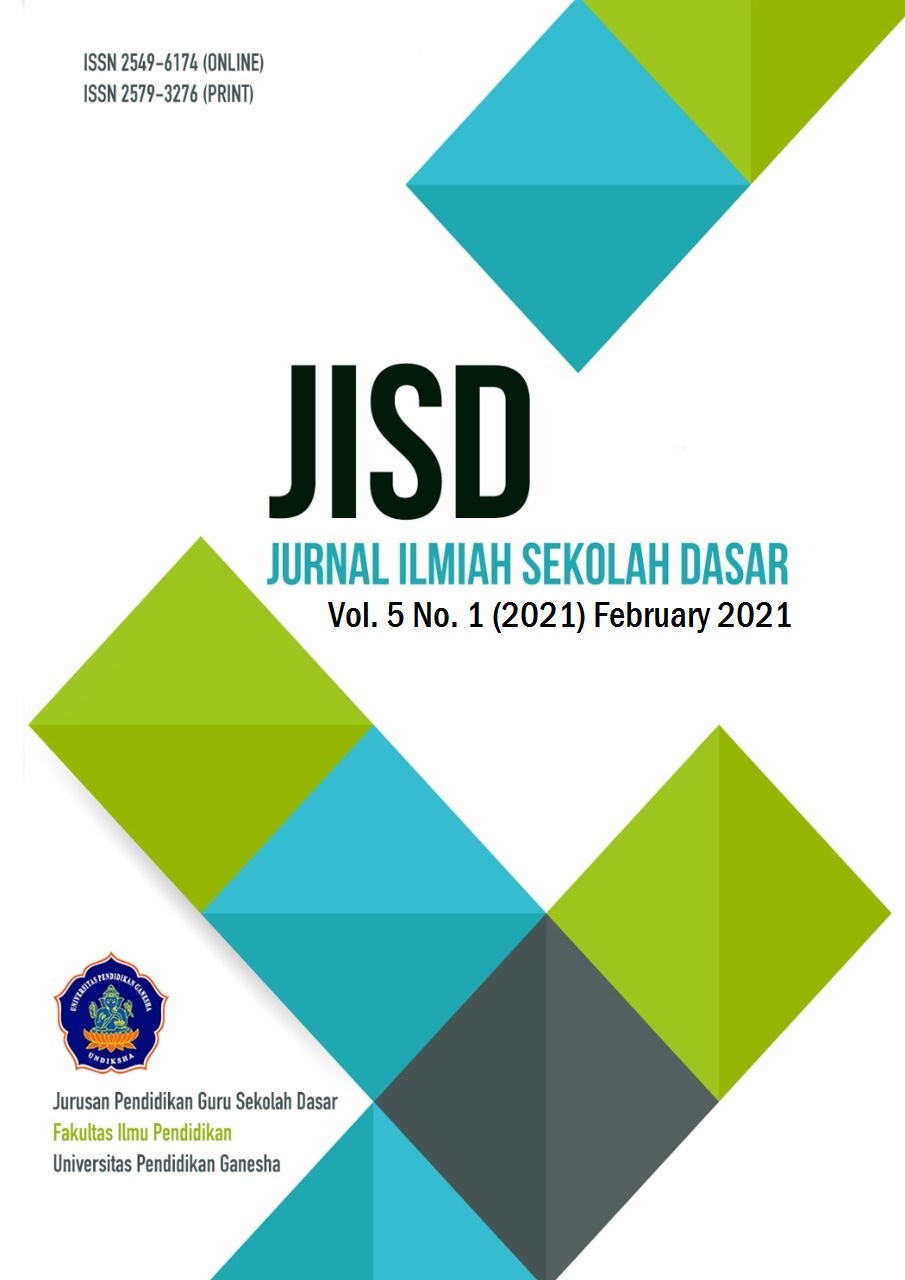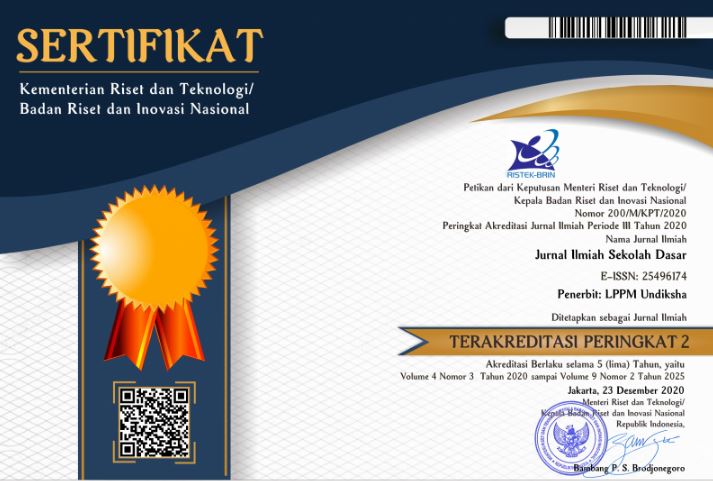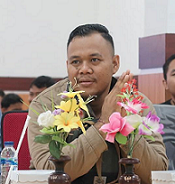The Credibility of Listening Learning Videos for Elementary School Students
DOI:
https://doi.org/10.23887/jisd.v5i1.34369Kata Kunci:
learning videos, listeningAbstrak
The limitations of appropriate learning media in online learning make listening skills difficult to teach. The purpose of this study is to develop listening learning videos for first-grade elementary students. This research is development research using ADDIE model, analysis, design, development, implementation, and evaluation. However, due to the pandemic situation, this research is only carried out until the development stage. The subjects in this study were two media experts, two material experts, and two practitioners. The method of data collection used in this study is the questionnaire method. The validity of the learning video is measured using the instrument rating scale in the form of an assessment sheet. Data analysis techniques use qualitative descriptive analysis and quantitative descriptive analysis. This study produced a listening learning video for first-grade elementary school students. The average validation score obtained in the listening learning video is 4.71, and the average material validation score is 4.81, with excellent criteria. Based on the study results, listening learning videos are declared valid and can be used in learning.
Referensi
Agung, A. A. (2016). Statistik Dasar untuk Pendidikan. Depublish.
Amilia, H. S., Eka, P. A., & Henry, P. (2019). Pengembangan Media Video Pembelajaran Untuk Meningkatkan Pemahaman Materi Gaya Kelas IV Di SDN Sukoiber 1 Jombang. JINOTEP (Jurnal Inovasi Dan Teknologi Pembelajaran) Kajian Dan Riset Dalam Teknologi Pembelajaran, 6(1), 45–50. http://dx.doi.org/10.17977/um031v6i12019p045.
Anugrahana, A. (2020). Hambatan, Solusi dan Harapan: Pembelajaran Daring Selama Masa Pandemi Covid-19 Oleh Guru Sekolah Dasar. Scholaria: Jurnal Pendidikan Dan Kebudayaan, 10(3), 282–289. https://doi.org/10.24246/j.js.2020.v10.i3.p282-289.
Arsyad. (2014). Media Pembelajaran. PT. Raja Grafindo Persada.
Arthur, R., Wijayanti, I., & Sidik, J. (2021). Occupational Health and Safety Animated Learning Videos : Validity and Feasibility. 10(1), 1–11. https://doi.org/10.23887/jpi-undiksha.v10i1.25192.
Astika, R. T., Astra, I. M., Makmuri, M., Sumarni, S., Andika, W. D., & Palupi, E. K. (2019). Survey of Elementary School Teacher Needs on Video Learning Mathematics Based on Contentextual Teaching and Learning in Pelembang City. Al-Jabar : Jurnal Pendidikan Matematika, 10(2), 251–260. https://doi.org/10.24042/ajpm.v10i2.4936.
Barseli, M., & Ifdil, I. (2017). Konsep Stres Akademik Siswa. Jurnal Konseling Dan Pendidikan, 5(3), 143. https://doi.org/10.29210/119800.
Busyaeri, A., Udin, T., & Zaenudin, A. (2016). Pengaruh Penggunaan Video Pembelajaran Terhadap Peningkatan Hasil Belajar Mapel IPA Di Min Kroya Cirebon. Al Ibtida: Jurnal Pendidikan Guru MI, 3(1), 116–137. https://doi.org/10.24235/al.ibtida.snj.v3i1.584.
Cahyati, N., & Kusumah, R. (2020). Peran Orang Tua Dalam Menerapkan Pembelajaran Di Rumah Saat Pandemi Covid 19. Jurnal Golden Age, 4(01), 4–6. https://doi.org/10.29408/jga.v4i01.2203.
Corina Manta, O., & Gabriela Enache, R. (2020). Online learning of socio-emotional behaviors in primary education during the COVID 19 pandemic. Case study. Technium Social Sciences Journal, 6, 92–98. https://techniumscience.com/index.php/socialsciences/article/view/2662.
Dewi, W. A. F. (2020). Dampak COVID-19 terhadap Implementasi Pembelajaran Daring di Sekolah Dasar. Edukatif : Jurnal Ilmu Pendidikan, 2(1), 55–61. https://doi.org/10.31004/edukatif.v2i1.89.
Dhir, S., Ramesh, S., & Kaur, M. J. (2021). Knowledge on Online Learning , Barriers and Challenges Faced by the Yound adult Student d uring Online Learning ” ( Colleges in Pune ) - A Descriptive Study. 25(4), 10336–10343. https://annalsofrscb.ro/index.php/journal/article/view/3796.
Diputra, K. S. (2016). Pengembangan Multimedia Pembelajaran Tematik Integratif Untuk Siswa Kelas IV Sekolah Dasar. JPI (Jurnal Pendidikan Indonesia), 5(2), 125. https://doi.org/10.23887/jpi-undiksha.v5i2.8475.
Doludea, A., & Nuraeni, L. (2018). Meningkatkan Keterampilan Menyimak Pada Anak Usia Dini 5-6 Tahun Dengan Metode Bercerita Melalui Wayang Kertas Di TK Makedonia. CERIA (Cerdas Energik Responsif Inovatif Adaptif), 1(1), 1. https://doi.org/10.22460/ceria.v1i1.p1-5.
Fadhli, M. (2015). Pengembangan Media Pembelajaran Berbasis Video Kelas IV Sekolah Dasar. Jurnal Dimensi Pendidikan Dan Pembelajaran, 3(1), 24–29. https://doi.org/10.24269/dpp.v3i1.157.
Hasyim Taufiq Ridlo, Omon Abdurrakhman, Y. P. (2015). Meningkatkan Motivasi Belajar Dan Hasil Belajar Siswa Dalam Pembelajaran Tematik Terpadu Melalui Pendekatan Saintifik. Jurnal Pendidikan Guru Sekolah Dasar, 2(1). https://doi.org/DOI: http://dx.doi.org/10.30997/dt.v2i1.299.
Hendryadi, H. (2017). Validitas Isi: Tahap Awal Pengembangan Kuesioner. Jurnal Riset Manajemen Dan Bisnis (JRMB) Fakultas Ekonomi UNIAT, 2(2), 169–178. https://doi.org/10.36226/jrmb.v2i2.47.
Ilhami, R. S., & Rimantho, D. (2017). Penilaian Kinerja Karyawan dengan Metode AHP dan Rating Scale. Jurnal Optimasi Sistem Industri, 16(2), 150–157. https://doi.org/10.25077/josi.v16.n2.p150-157.2017.
Imam, I. (2014). Meningkatkan Kemampuan Menyimak Siswa Kelas I Melalui Teknik Permainan Pesan Berantai Pada Pembalajaran Bahasa Indonesia. PEDAGOGIA: Jurnal Pendidikan, 3(2), 111. https://doi.org/10.21070/pedagogia.v3i2.62.
Juwantara, R. A. (2019). Analisis Teori Perkembangan Kognitif Piaget Pada Tahap Anak Usia Operasional Konkret 7-12 Tahun dalam Pembelajaran Matematika. Jurnal Ilmiah Pendidikan Guru Madrasah Ibtidaiyah, 9(1), 27–34. https://doi.org/10.18592/aladzkapgmi.v9i1.3011.
Krishnan, A. G., Srisai Devikrishna, D., & Aich, S. C. (2021). Online education amidst pernicious covid scourge: Altering traditional educational system and implementation of arts-friendly distance education strategies. Annals of the Romanian Society for Cell Biology, 25(4), 7470–7475. https:///annalsofrscb.ro/index.php/journal/article/view/3379.
Marius Panje, Sihkabuden, A. J. . T. (2016). Pengembangan Video Pembelajaran Bahasa Indonesia Teknik Membaca Puisi. Jurnal Pendidikan: Teori, Penelitian, Dan Pengembangan, 1, 1473–1478. http://dx.doi.org/10.17977/jp.v1i8.6617.
Mashuri, D. K., & Budiyono. (2009). Pengembangan Media Pembelajaran Video Animasi Materi Volume Bangun Ruang untuk SD Kelas V. Pengembangan Media Video Animasi, 8(5), 893–903.
Maulana, A. (2021). Perancangan buku menggambar huruf dengan teknik grid untuk tipografer pemula. Jurnal Pendidikan Seni Rupa, 6(2), 9–15. https://doi.org/10.30738/cilpa.v6i2.9842.
Mulyani Aziz, Y., & Fatimah, N. (2020). Focus Group Discussions E-Learning based on Prior Knowledge and Problems in the Covid-19 Pandemic Period. Technium Social Sciences Journal, 6. https://doi.org/10.47577/tssj.v9i1.1033.
Mumtahabah, N. (2014). Penggunaan Media Visual Dalam Pembelajaran PAI Nurotun Mumtahanah 1. AL HIKMAH Jurnal Studi Keislaman, Volume 4, Nomor 1, Maret 2014, 4(1), 2–14. https://doi.org/10.21154/cendekia.v14i2.610.
Nengrum, T. A., Pettasolong, N., & Nuriman, M. (2021). Kelebihan dan Kekurangan Pembelajaran Luring dan Daring dalam Pencapaian Kompetensi Dasar Kurikulum Bahasa Arab di Madrasah Ibtidaiyah 2 Kabupaten Gorontalo. Jurnal Pendidikan, 30(1), 1–12. https://doi.org/10.32585/jp.v30i1.1190.
Novita, L., Sukmanasa, E., & Pratama, M. Y. (2019). Penggunaan Media Pembelajaran Video terhadap Hasil Belajar Siswa SD. Indonesian Journal of Primary Education Penggunaan, 3(2), 64–72. https://doi.org/ 10.17509/ijpe.v3i2.22103.
Nugroho, E. (2018). Prinsip-prinsip Menyusun Kuesioner. UB Press.
Park, S. Y., & Kang, S. J. (2021). The effects of maternity video education on learning motivation, learning achievement, learning immersion and major satisfaction. Annals of the Romanian Society for Cell Biology, 25(1), 878–882. https:// annalsofrscb.ro/index.php/journal/article/view/187.
Permatasari, I. S., Hendracipta, N., & Pamungkas, A. S. (2019). Pengembangan Media Pembelajaran Video Animasi Hands Move Dengan Konteks Lingkungan Pada Mapel IPS. Jurnal Pendidikan Dan Pembelajaran Dasar, 6(1), 34–48. https://doi.org/10.24042/terampil.v6i1.4100.
Prihatin, Y. (2017). Problematika Keterampilan Menyimak Dalam Pembelajaran Bahasa Indonesia. Sastranesia, 5(3), 45–52. https://garuda.ristekbrin.go.id/documents/detail/896198.
Purba, R. (2016). Tipografi Kreasi Motif Gorga Batak. Jurnal Proporsi, 1(2), 190–201. http://dx.doi.org/10.22303/proporsi.1.2.2016.190-201.
Rahmawati, N. S., Santoso, A., & Andajani, K. (2017). Respons Siswa Kelas Vii Terhadap Pembelajaran Teks Laporan Hasil Observasi Dengan Media Video Pengetahuan. Jurnal Pendidikan, 2(1), 1092–1096. http://dx.doi.org/10.17977/jptpp.v2i8.9840.
Ramprathap, K. (2021). Using Social Media as an Learning Tool on Students ’ Collaborative Learning Using SEM Model with the Reference to Engineering Students in Tamil Nadu. Annals of the Romanian Society for Cell Biology, 25(4), 9689–9694. http://annalsofrscb.ro/index.php/journal/article/view/3713.
Ratminingsih, N. M. (2016). Efektivitas Media Audio Pembelajaran Bahasa Inggris Berbasis Lagu Kreasi Di Kelas Lima Sekolah Dasar. JPI (Jurnal Pendidikan Indonesia), 5(1), 27. https://doi.org/10.23887/jpi-undiksha.v5i1.8292.
Riyanto, A., & Yunani, E. (2020). the Effectiveness of Video As a Tutorial Learning Media in Muhadhoroh Subject. Akademika, 9(02), 73–80. https://doi.org/10.34005/akademika.v9i02.1088.
Sadikin, A., & Hamidah, A. (2020). Pembelajaran Daring di Tengah Wabah Covid-19. Biodik, 6(2), 109–119. https://doi.org/10.22437/bio.v6i2.9759.
Shelly, M., Joshi, M. B., & Singh, A. (2021). COVID Pandemic and Connecting Nursing Students with E-Learning : Challenges for Nursing Educators – A Way Forward ? Annals of the Romanian Society for Cell Biology, 25(6), 247–255. https://annalsofrscb.ro/index.php/journal/article/view/5297.
Siyoto, S., & Muhamad Ali Sodik. (2015). Dasar Metodologi Penielitian. Literasi Media Publishing.
Suprapto, H. (2016). Implementasi Lesson Study dalam Pembelajaran Pendidikan Kewarganegaraan Berbasis Video pada Kelas XII IPS SMAN 1 Ponorogo. Jurnal Dimensi Pendidikan Dan Pembelajaran, 5(Januari), 29–37. https://doi.org/10.24269/dpp.v4i1.51.
Suryansah, T., & Suwarjo, S. (2016). Pengembangan Video Pembelajaran Untuk Meningkatkan Motivasi Dan Hasil Belajar Kognitif Siswa Kelas IV SD. Jurnal Prima Edukasia, 4(2), 209. https://doi.org/10.21831/jpe.v4i2.8393.
Syarifudin, A. S. (2020). Impelementasi Pembelajaran Daring Untuk Meningkatkan Mutu Pendidikan Sebagai Dampak Diterapkannya Social Distancing. Jurnal Pendidikan Bahasa Dan Sastra Indonesia Metalingua, 5(1), 31–34. https://doi.org/10.21107/metalingua.v5i1.7072.
Tegeh, I. M., & Kirna, I. M. (2013). Pengembangan Bahan Ajar Metode Penelitian Pendidikan Dengan Addie Model. Jurnal Ikatan Alumni (IKA) Universitas Pendidikan Ganesha, 11(1).
Ulfah, D. M., & Soenarto, S. (2017). Pengaruh penggunaan media video dan gambar terhadap keterampilan menulis kelas V. Jurnal Prima Edukasia, 5(1), 22–34. https://doi.org/10.21831/jpe.v5i1.7693.
Villegas, V., Preiolo, S., Rocca, M., Ipince, A., & Bakrania, S. (2020). Impacts of Health-Related School Closures on Child Protection Outcomes: A review of evidence from past pandemics and epidemics and lessons learned for COVID-19 Cirenia. Pharmacological Research, 104743. https://doi.org/10.1016/j.ijedudev.2021.102431.
Yusantika, F. D., Suyitno, I., & Furaidah, F. (2018). Pengaruh Media Audio dan Audio Visual terhadap Kemampuan Menyimak Siswa Kelas IV. Jurnal Pendidikan: Teori, Penelitian, Dan Pengembangan, 3(2), 251–258. http://dx.doi.org/10.17977/jptpp.v3i2.10544.
Unduhan
Diterbitkan
Cara Mengutip
Terbitan
Bagian
Lisensi
Authors who publish with the Journal Ilmiah Sekolah Dasar agree to the following terms:
- Authors retain copyright and grant the journal the right of first publication with the work simultaneously licensed under a Creative Commons Attribution License (CC BY-SA 4.0) that allows others to share the work with an acknowledgment of the work's authorship and initial publication in this journal.
- Authors are able to enter into separate, additional contractual arrangements for the non-exclusive distribution of the journal's published version of the work (e.g., post it to an institutional repository or publish it in a book), with an acknowledgment of its initial publication in this journal.
- Authors are permitted and encouraged to post their work online (e.g., in institutional repositories or on their website) prior to and during the submission process, as it can lead to productive exchanges, as well as earlier and greater citation of published work. (See The Effect of Open Access)










